#Io transiting Jupiter
Text
Thanks for the tag, @disorderlyadjustment
I now have to post my lock screen, last song I listened to, last picture I saved, and last picture I took
(Well, don't have to, but I'll play along lmao)
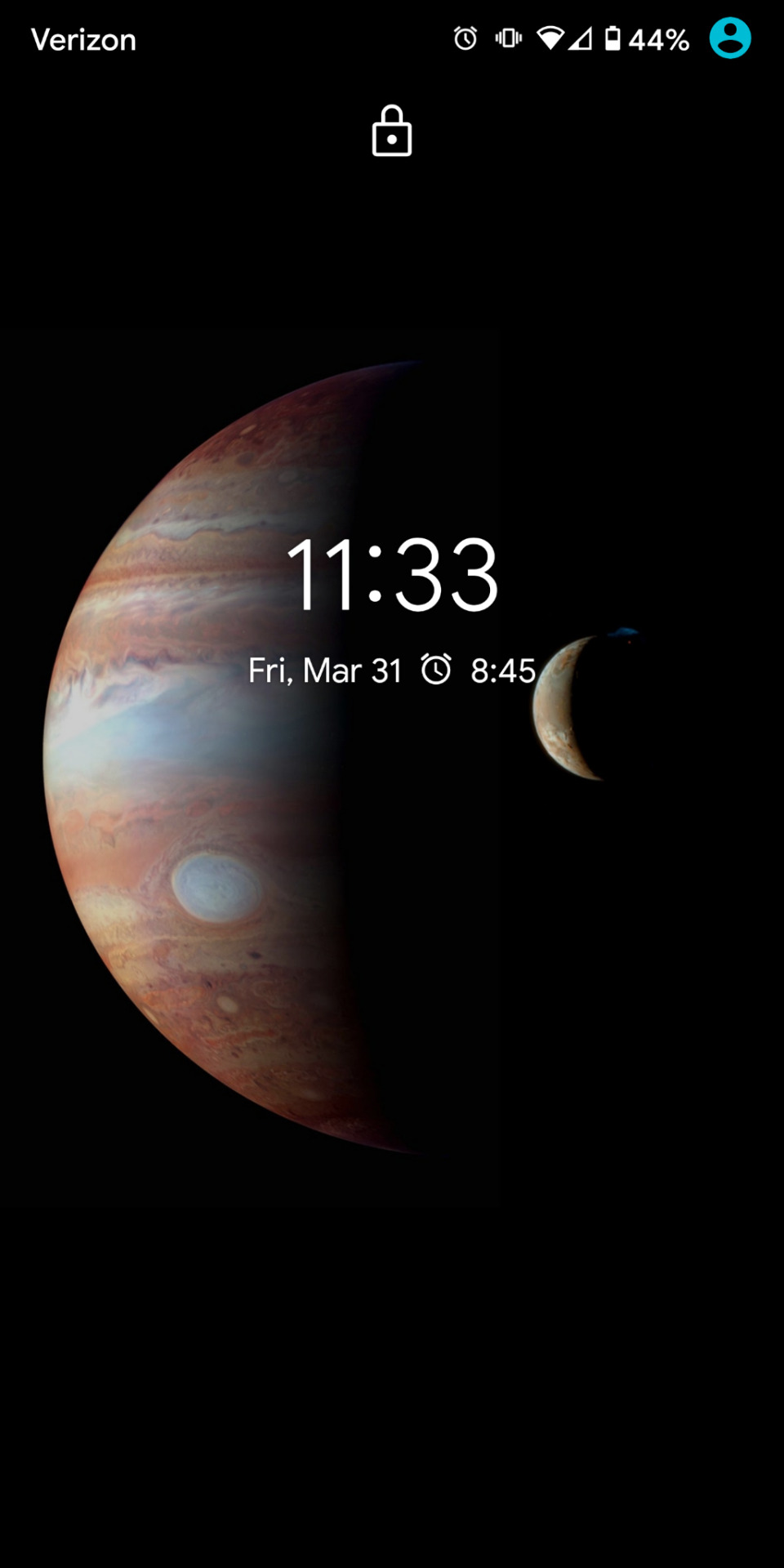

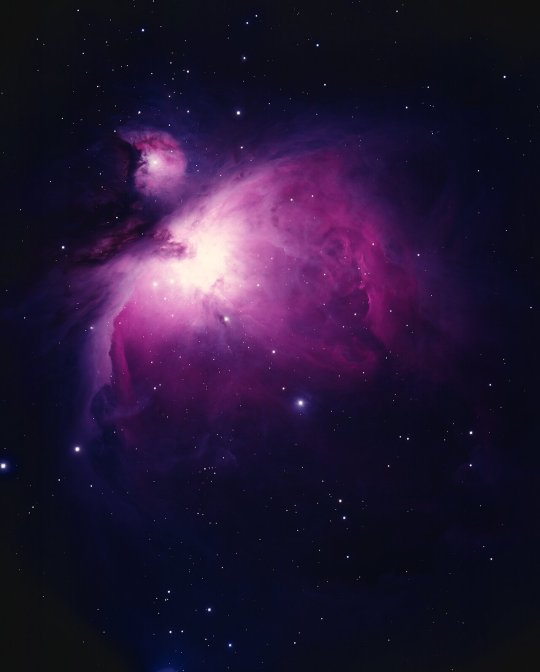

@pizzopaps, @annoyinglylogical, @skellagirl, @watchtowertoarrow, aaaaand @butchgomez, if any of you wanna participate, you're more than welcome ❤️
#Io transiting Jupiter#Mr. Magic - Reliqa#the Orion nebula by Hubble#me ft new haircut (baby's first undercut) from my partner 🥰#tag game
11 notes
·
View notes
Text
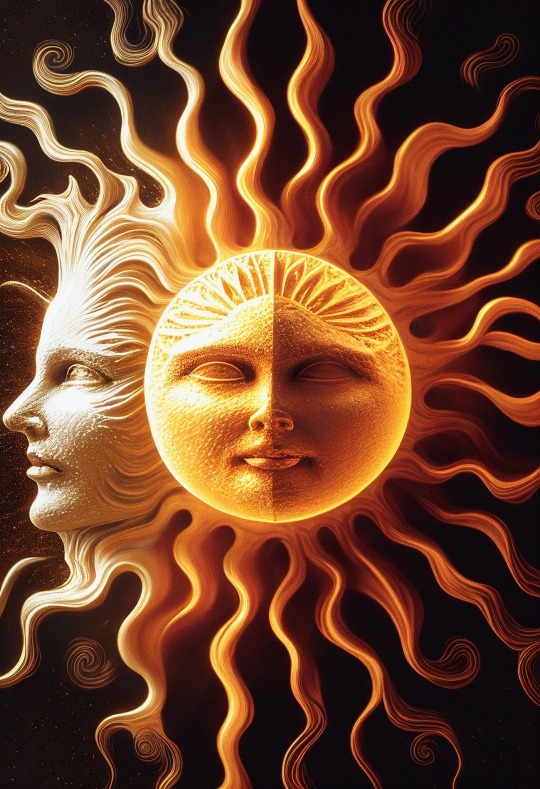
Sunday, January 28
Tonight let’s check in with Uranus in the constellation Aries, which it shares with the mighty planet Jupiter.
The latter planet stands out as the brightest point of light high in the south an hour after sunset. Let’s start with it first: Jupiter shines at magnitude –2.4 and is a treat to view through a telescope. Its disk stretches 40″ across and is flanked by its four largest moons, Io, Europa, Ganymede, and Callisto. For most of the night, Europa and Ganymede sit to the west, while Callisto and Io lie east of the planet. But Io is closing in on Jupiter’s eastern limb; it crosses onto the cloud tops around 8:45 P.M. EST to begin a transit. It isn’t joined by its shadow for more than an hour, the round blot appearing just after 10 P.M. EST, when Io is more than halfway across the disk. Io slips away to the west just before 11 P.M. EST, while its shadow continues to cross for another 80 minutes or so. Those on the East Coast will likely lose sight of the planet before the shadow transit can end.
To spot Uranus, look about 12.1° east of Jupiter, or about half the distance between the gas giant and the Pleiades star cluster in Taurus. Uranus is magnitude 5.7, roughly the limit for naked-eye observing. You’ll need a very dark observing site to spot it; regardless, it will be easy to pick up in binoculars or any telescope. The ice giant’s disk is just 4″ across and will look like a grayish, “flat” star. Now that the planet has reached its stationary point, it will begin moving eastward, or prograde, with respect to the more distant background stars.
Sunrise: 7:12 A.M.
Sunset: 5:14 P.M.
Moonrise: 8:11 P.M.
Moonset: 8:57 A.M.
Moon Phase: Waning gibbous (92%)
Sun & Uranus
Talon Abraxas
25 notes
·
View notes
Text


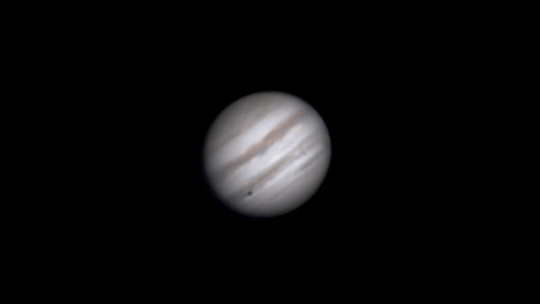
my first try at saturn from december, and jupiter's Io shadow transit from tonight!
these were taken with a 8" dob, a 2.5x barlow, and an ASI585MC
#space#astronomy#jupiter#saturn#astrophotography#oh how i wish i could try saturn again with what ive learned!#alas its below the trees by the time the sun sets now#but its been very fun and i have much to learn still#its hard to see io on top of jupiter so included the gif#i really wish i got more detail on that
16 notes
·
View notes
Text
Today's Current Affairs: NASA's Juno spacecraft discovers Jupiter's elusive fifth moon, Amalthea
NASA's Juno spacecraft recently captured a glimpse of Jupiter's fifth moon, Amalthea, as it transited the planet's iconic Great Red Spot. This small but intriguing natural satellite is often overshadowed by its larger siblings, but its mysterious qualities continue to pique the interest of researchers. Amalthea, resembling a potato in shape, is believed to emit more heat than it receives from the Sun, leading to various theories about its energy source. As exploration of this enigmatic moon continues, scientists hope to uncover the truth behind its unique characteristics.
[ad_2]
Download Latest Movies in HD Quality
Downloading In 15 seconds
Scroll Down to End of This Post
const downloadBtn = document.getElementById('download-btn');
const timerBtn = document.getElementById('timer-btn');
const downloadLinkBtn = document.getElementById('download-link-btn');
downloadBtn.addEventListener('click', () =>
downloadBtn.style.display = 'none';
timerBtn.style.display = 'block';
let timeLeft = 15;
const timerInterval = setInterval(() =>
if (timeLeft === 0)
clearInterval(timerInterval);
timerBtn.style.display = 'none';
downloadLinkBtn.style.display = 'inline-block';
// Add your download functionality here
console.log('Download started!');
else
timerBtn.textContent = `Downloading In $timeLeft seconds`;
timeLeft--;
, 1000);
);
[ad_1]
1. How many moons does Jupiter have in total?
a) 90
b) 97
c) 101
d) 95
Answer: d) 95
2. What are the names of Jupiter's four largest moons?
a) Titan, Triton, Europa, Ganymede
b) Callisto, Io, Phobos, Deimos
c) Ganymede, Europa, Callisto, Amalthea
d) Io, Europa, Ganymede, Callisto
Answer: d) Io, Europa, Ganymede, Callisto
3. How does scientists describe the shape of Amalthea?
a) Perfect sphere
b) Oval
c) Cubical
d) Potato
Answer: d) Potato
4. Why is Amalthea shrouded in mystery according to scientists?
a) Its unusual color
b) The mysterious glow it emits
c) Its irregular shape
d) The extra heat it emits compared to what it receives from the Sun
Answer: d) The extra heat it emits compared to what it receives from the Sun
[ad_2]
What did NASA's Juno spacecraft spot earlier this year?
NASA's Juno spacecraft spotted the elusive fifth moon of Jupiter, known as Amalthea.
What is special about Amalthea?
Amalthea is Jupiter's fifth largest moon out of the 95 known moons. It has humble dimensions, resembling a potato and made up of loosely held-together rubble pile rather than solid rock.
When was Amalthea spotted by Juno?
Amalthea was spotted by Juno on March 7 as it passed by Jupiter for the 59th time.
Why is Amalthea shrouded in mystery?
Amalthea is shrouded in mystery because scientists believe it emits more heat than it receives from the Sun, and it's still unknown where this extra energy is coming from.
What are some theories regarding the heat emitted by Amalthea?
One theory is that Amalthea receives heat directly and indirectly from Jupiter. Another theory suggests that heat may be produced by tidal pressures within Amalthea caused by Jupiter's tight grasp.
Why is Amalthea often forgotten in scientific discussions?
Amalthea is often forgotten in scientific discussions because its significance is overshadowed by that of its four larger siblings - Io, Europa, Ganymede, and Callisto. However, continued exploration is necessary to unravel the truth about this mysterious natural satellite.
[ad_1]
Download Movies Now
Searching for Latest movies 20 seconds
Sorry There is No Latest movies link found due to technical error. Please Try Again Later.
function claimAirdrop()
document.getElementById('claim-button').style.display = 'none';
document.getElementById('timer-container').style.display = 'block';
let countdownTimer = 20;
const countdownInterval = setInterval(function()
document.getElementById('countdown').textContent = countdownTimer;
countdownTimer--;
if (countdownTimer < 0)
clearInterval(countdownInterval);
document.getElementById('timer-container').style.display = 'none';
document.getElementById('sorry-button').style.display = 'block';
, 1000);
[ad_2]
Today's Current Affairs brought news of NASA's Juno spacecraft discovering the elusive fifth moon of Jupiter, named Amalthea. This small but intriguing natural satellite was spotted as it passed in front of Jupiter's Great Red Spot. Amalthea, which is dwarfed by its larger siblings, measures 250 km at its longest point and 128 km at its narrowest. Scientists believe this moon resembles a potato and is more of a rubble pile than solid rock. Juno captured this rare sight on its 59th flyby of Jupiter, revealing Amalthea as a tiny black dot against the planet's red cloud bands. The mystery surrounding Amalthea's heat emissions, exceeding what it receives from the Sun, continues to puzzle researchers, with theories pointing towards both direct and indirect heat sources from Jupiter and internal tidal pressures. Despite being overshadowed by its giant siblings, Amalthea's significance in our understanding of Jupiter's moons cannot be ignored.
[ad_1]
0 notes
Text
Jupiter and Io

Antonio da Correggio, Jupiter and Io (1532–1533). Oil on canvas, 163.5 cm × 70.5 cm. Kunsthistorisches Museum, Vienna.
Antonio Allegri da Correggio's Jupiter and Io, a masterpiece from the High Renaissance, offers a fascinating glimpse into the amalgamation of divine mythology and sensual expression. This analysis seeks to explore the various facets of this captivating work, painted circa 1530.
Mythological Backdrop:
The painting is based on a tale from Ovid's Metamorphoses, where Jupiter, the king of the gods, seduced Io, a mortal woman. Correggio portrays this mythological encounter with a blend of divine grandeur and intimate tenderness. Jupiter, disguised as a cloud, envelopes Io, depicting the moment of their union.
Artistic Technique and Style:
Correggio is renowned for his skillful use of sfumato, a technique that creates soft, gradual transitions between colours and tones, akin to smoke or vapor. This technique is masterfully employed to render the cloud form of Jupiter, merging seamlessly with Io’s figure. The fluidity and delicacy of his brushwork lend an ethereal quality to the scene, enhancing its dreamlike and sensual ambiance.
The Sensuality of the Divine:
A striking aspect of Jupiter and Io is its explicit sensuality. Correggio does not shy away from portraying a bold, erotic theme, a daring choice for his time. Io's blissful expression and the tangible depiction of her embrace with the cloud illustrate a harmonious blend of the human and divine realms.
Symbolism and Interpretation:
The painting is rich in symbolism. The cloud not only represents Jupiter's disguise but also suggests the elusive and omnipresent nature of the divine. Io’s yielding posture and closed eyes might symbolize the surrender to higher powers or the overwhelming nature of divine encounters.
Contextual Significance:
Created during the High Renaissance, a period known for its humanistic approach to art, Jupiter and Io reflects the era's fascination with classical mythology and its exploration of human emotions and experiences, even in divine narratives.
Myth and Sensuality: Your View
How does Correggio’s depiction of the divine in Jupiter and Io resonate with your understanding of mythology and art? Do you see this painting as a celebration of love and sensuality, or as a reflection of the power dynamics between the mortal and the divine?
#Correggio#JupiterAndIo#RenaissanceArt#MythologyInArt#ItalianMasters#ArtHistory#SensualArt#DivineArt#ClassicalMythology#HighRenaissance#ArtAnalysis#MasterpieceExploration#ArtBlogger#CorreggioArt#SfumatoTechnique#ArtAndMythology
0 notes
Video
youtube
"LP791-18d: 地球サイズの太陽系外惑星発見、火山活動と潮汐力による加熱の可能性を明らかに "
スピッツァーとTESS(テス)が、画期的な発見をした太陽系外惑星をご紹介します。自然のパワーと美しさを魅惑的に描き出す異世界の火山の驚異!
NASAによる太陽系外惑星の驚異を解き明かすブレイクスルー。
惑星地質学の驚異を目の当たりにし、遠く離れた系外惑星の地質学的
タペストリーを解明する上で極めて重要な役割を果たしました。
系外惑星を形成する潮汐力の背後にある科学を掘り下げ、
解読されるのを待っている宇宙の複雑な領域である
潮汐熱力学の興味深い領域に突入します。
太陽系外惑星に視線を向け、宇宙の最も驚くべき宝物を明らかにし、
遠い世界の無限の可能性に思いを馳せることで、
あなたの視野を地球外へと広げます。
🎦動画でご紹介した関連動画🎦
【太陽系第2惑星「金星」】地球の兄弟星・ 磁場を持たない熱い大気に覆われた惑星
https://youtu.be/R3u_lfEFCpc
※磁場を持たない厚い大気を持つ惑星。大気や水を太陽風から守る鍵が隠されている!?
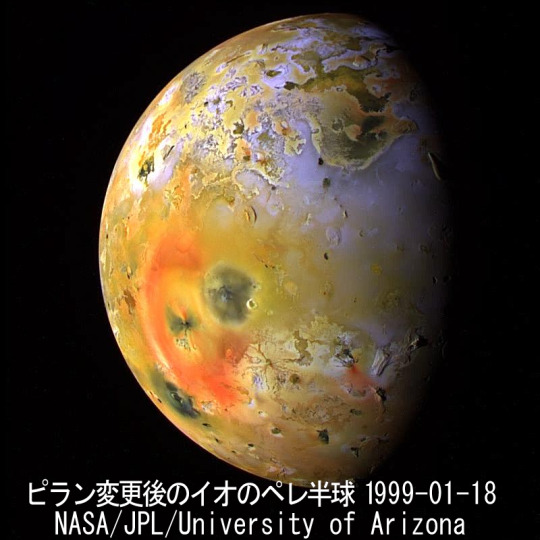
【木星の第1衛星「イオ」】太陽系最大の火山とマグマの月 人類にとって過酷な3つの恐怖!
https://youtu.be/xcRDrSqoVek
※系外惑星「LP 791-18」と同程度の火山を持つと言われています。
大気が大量に存在する可能性があり「系外惑星」に大量の大気をもたらすメカニズムが!?
📝目次📝
-------------------------------------------------
0:00 今回のテーマ
0:39 発見した望遠鏡
1:00 見える方角と距離
1:25 惑星LP-791-18dとは
2:50 注目する理由
3:35 太陽風と磁場の関係
4:08 金星の大気が守られる原因
5:35 系外惑星の大量火山の理由
7:30 スピッツァー望遠鏡の功績
8:15 木星の衛星「イオ」最新映像
どうぞ、最後までお楽しみください。
⭐️チャンネル登録はこちらから⭐️
https://www.youtube.com/@soranohoshi

このチャンネルでは、宇宙や星空の情報や知識を親しみやすく、
ゲームやアニメ感覚でシェアしていくチャンネルです。
今後の動向や、宇宙や星々に興味がわきましたら、
是非!チャンネル登録もしていただけると嬉しいです。
アンケートや感想、いいねボタンも大変励みになります。
お気軽にご参加ください。
日々の星空ライフを充実したものに。
今後、人類のさらなる宇宙への挑戦を見守っていきましょう。
📣割愛・こぼれ話📣
-------------------------------------------------
▼おすすめ資料
イオ - NASA 太陽系探査
https://solarsystem.nasa.gov/moons/jupiter-moons/io/in-depth/
木星の火山衛星イオの 3D モデルあり。
最も火山活動が活発なスポットの地名や、
イオの内部構造モデルをマウス操作で眺めることができます。
▼磁場(惑星の) | 天文学辞典より
https://astro-dic.jp/planetary-magnetic-fields/
水星 〇
金星 ×(過去にあったかどうか不明)
地球 〇
火星 ×(かつてあったが今はない)
天文学辞典より引用>
現在の火星には磁場はないが、表面の地殻に残留磁化があり、
過去に地球と同様の磁場が存在していた時期があったことを示唆している。
金星も現在は磁場がない。金星の場合、地表温度が高く磁性が失われる
キュリー温度に近いので残留磁化は確認されていない。
このため金星で過去に磁場が存在したかどうかはわからない。
🎵スピッツァー宇宙望遠鏡: ミュージカル🎵
https://youtu.be/Gn0JMsdOhjU
NASA監督者が歌でスピッツァー宇宙望遠鏡について、
そして赤外線天文学がハッブルのような可視光望遠鏡と
どのように違うのかを歌います♪
🎬気になるグッズ・映画🎬
以下、一部リンクにはアフェリエイト【PR】が含まれます。
-------------------------------------------------
▼火山の力で暖かい メンズインナーシャツ 防寒 99.9%抗菌で臭くない Vネック
【PR】https://a.r10.to/hU3OH0
▼火山の力で暖かい レディースインナーシャツ 防寒 99.9%抗菌で臭くない Uネック
【PR】https://a.r10.to/hUqJre
▼火山フットマスク 140g 角質ケア マッサージ
【PR】https://a.r10.to/huNohd
▼火山ティッシュディスペンサー 日本製 おもしろ雑貨
【PR】https://a.r10.to/hNbEtE
▼火山石 中粒 黒(約10mm〜20mm)1kg 化粧、飾り石
【PR】https://a.r10.to/hU0skW
▼火山オブジェ エアレーション水槽用 熱帯魚インテリア
【PR】https://a.r10.to/hNZGSA
📘資料・出典📘
-------------------------------------------------
・フリー百科事典『ウィキペディア(Wikipedia)』
・天文学辞典:天体に関する用語を3,000語以上収録・解説。
https://astro-dic.jp/
●太陽系外惑星データベース
http://www.exoplanetkyoto.org/
●TESS - トランジット系外惑星調査衛星 | NASA
https://www.nasa.gov/tess-transiting-exoplanet-survey-satellite
●Spitzer Space Telescope
https://www.spitzer.caltech.edu/
▼金星の大気は太陽風を阻む アストロアーツhttps://www.astroarts.co.jp/article/hl/a/12929_venus
📀使用ソフト📀
-------------------------------------------------
▼Space Engine –宇宙シミュレーターソフト
http://spaceengine.org/
ロシアの天文学者でプログラマによる独自の3D宇宙空間
シミュレーションソフトウェアおよびゲームエンジン。
※当動画は、Proライセンスを取得して配信しています。
▼ステラナビゲータ12/AstroArts
最新版・純国産の天文シミュレーションソフトウェア。
【PR】https://a.r10.to/hU8Ip9
▼Universe Sandbox 2 宇宙物理シミュレーションソフトhttp://universesandbox.com/
▼CeVIO AI さとうささら すずき つづみ 弦巻マキ(日本語&英語)
深層学習等のAI技術を使い、声質・癖・喋り方をリアルに再現した
新世代の音声創作ソフトウェア最新版!
【Amazon PR】さとうささら(トークスターター|ダウンロード版)https://amzn.to/3srohGr
【楽天 PR】弦巻マキ トークスターターパック (日本語&英語) Windows用https://a.r10.to/hNL2BI
【Amazon PR】すずきつづみ(トークスターター|ダウンロード版)https://amzn.to/3sjDGZz
この動画はCeVIOプロジェクトの「さとうささら」「弦巻マキ」「すずきつづみ」を使用しています。
🎬おすすめ動画リスト🎬
▼【太陽系惑星 JWST特集】ジェイムズ・ウェッブ宇宙望遠鏡が観測した太陽系惑星特集
https://youtube.com/playlist?list=PLVD9xZXaEKsUJRyPWLLqIVtFQkJ_DZkOR
🔽ブログやSNS🔽
⭐️宙の星ブログ⭐️
https://soranohoshi.com/
0 notes
Link
A recent study published in the journal Geology attempts to interpret the patterns of dunes, which are sand mounds frequently formed by aeolian (wind) processes and range in size from small ripples observed on beaches to massive structures observed in the desert. Specifically, the researchers focused on patterns of dune crestlines, which are the top of the dunes. Different dune crestline patterns might appear as mundane features, but their formations are often the result of a myriad of influences, including climate change, surface processes, and atmospheric phenomena. However, questions pertaining to the processes responsible for the different crestline patterns have baffled scientists. But the findings from this recent study could provide researchers insights into environmental variances not only on Earth, but other dune-harboring planetary worlds in our own solar system. These currently include three of the four terrestrial planets, Venus, Earth, and Mars; smaller bodies such as Jupiter’s volcanic moon, Io; Saturn’s largest moon, Titan; and even dwarf planet Pluto. “When you look at other planets, all you have is pictures taken from hundreds to thousands of kilometers away from the surface,” said Dr. Mathieu Lapôtre, who is an assistant professor of Earth and planetary sciences in the Stanford Doerr School of Sustainability, and a co-author on the study. “You can see dunes – but that’s it. You don’t have access to the surface. These findings offer a really exciting new tool to decipher the environmental history of these other planets where we have no data.” Dune interactions are defined as when their crestlines are near one another, and it’s these interactions result in the dunes establishing a balance, or equilibrium, with their surrounding environment. Therefore, the researchers hypothesized that a large amount of dune interactions could be interpreted as recent or nearby changes regarding those confined conditions. For the study, the researchers analyzed changes in specific known environmental conditions, including sand quantity and wind direction, using orbital images of dune field sites numbering 30 and 16 on Earth and Mars, respectively. Examples of Earth dune field sites included Rice Valley, White Sands, the Namib Desert, and the Tengger Desert. Examples of Martian dune field sites included Nili Patera, Kaiser Crater, Rabe Crater, and Hargraves Crater. Examples of active dune fields within Nili Patera on Mars. Dunes like these were examined for this study in hopes of giving scientists better insights into how their interactions are influenced by a planet’s climate. (Credit: NASA/JPL-Caltech/Univ. of Arizona) Example of dune activity in Rabe Crater on Mars, one of the locations for this recent study investigating dune interactions. (Credit: NASA/JPL-Caltech/UArizona) Example of dune activity in Kaiser Crater on Mars, one of the locations for this recent study investigating dune interactions. (Credit: NASA/JPL-Caltech/UArizona) For Earth, the researchers flattened a dune field in China’s Tengger Desert to establish a baseline prior to analyzing satellite imagery between 2016 and 2022 of how this flat terrain evolved into large dunes as they slowly reached a state of equilibrium with their surrounding environment. This was followed by the team examining how wind conditions in the Namib Desert resulted in increased dune interaction as the dunes migrated throughout a valley whose landscape transitions from unrestricted to restricted then unrestricted afterwards. “As both sand and winds get funneled into the valley, the dunes feel a change in their boundary conditions, and their pattern needs to adjust,” said Colin Marvin, who is a PhD student in the Department of Earth and Planetary Sciences at Stanford, and lead author of the study. “They move into the portion outside the valley, and they again readjust to their unconfined conditions, and we see a drop in the number of interactions. This trend is exactly what we expected to see.” Time-lapse images of the Nili Patera dune field on Mars observed between 2007 and 2010. These images indicate dune ripple movement and are an example of what scientists observed in the Namib Desert on Earth for this study. (Credit: NASA) For Mars, the researchers used orbital imagery to discover similar dune patterns, specifically near the Martian north pole where the researchers observed minor amounts of dune interactions. This was due to the dunes reaching a state of equilibrium with their surrounding environment, resulting in relative spacing from each other and similar characteristics for both appearance and size. However, dunes observed in slightly lower latitudes exhibited greater amounts of interactions due to changing winds and local surface frost. But once these dunes migrate closer to the north pole, their patterns settle out resulting in decreased interactions. “We have an upper bound on the time that it takes for a given dune to adjust to changes in environmental conditions, and that is the time it takes for a dune to migrate by a distance of one dune length,” said Marvin. “We can use this to diagnose recent changes in environmental conditions on planetary bodies where we don’t have any information other than images taken from orbit or radar for example.” Dr. Lapôtre noted that gaining insights about dune patterns on Mars could not only help better understand Mars’ recent climate, but also assist in locating subsurface water ice that could be excavated by future astronauts on the Red Planet. As stated earlier, other planetary bodies besides Earth and Mars possess dunes that could be used to better understand climates on those worlds, with one such world being Saturn’s largest moon, Titan. In addition to its dunes, Titan is the only moon that possesses a thick atmosphere, which makes it a target for astrobiology and the search for life beyond Earth. This large moon was extensively investigated by NASA’s Cassini throughout the 2000s and 2010s with the European Space Agency’s Huygens probe touching down on Titan’s surface in January 2005. This made Huygens the first spacecraft to land on a planetary body in the outer solar system and the first landing on a moon aside from Earth’s Moon. While Huygens only transmitted data and images back to Earth for approximately 90 minutes, it provided scientists with a first-time, up-close look at one of the most intriguing moons in the solar system. This most recent study has helped scientists lay the foundation for helping us better understand dune interactions on other worlds, but NASA’s upcoming Dragonfly mission to Titan hopes to confirm these findings when it lands on the moon’s surface sometime in the 2030s. With this mission, Dragonfly will become only the second rotorcraft sent to another world—the first being NASA’s Ingenuity helicopter on Mars—and will mark the first powered flight on any moon. During its multi-year science mission, Dragonfly will perform short flights around Titan in hopes of determining its prebiotic chemistry and potential for extraterrestrial life but should also provide scientists an up-close investigation of its dunes, which have thus far only been observed from orbit. What new discoveries about dune interactions on Earth and other worlds will scientists make in the coming years and decades? Only time will tell, and this is why we science! As always, keep doing science & keep looking up! The post Interpreting Dune Patterns: Insights from Earth and Mars appeared first on Universe Today.
0 notes
Photo

At this point, we’ve settled on the 3x for point sources, 1x for larger objects. I didn’t bother posting the telephoto Moon this time, it was still mushy. Waning gibbous here this evening, crunchy terminator encroaching on the eastern maria. I did contemplate getting up to see the lunar eclipse on Tuesday morning, but it just didn’t happen. Everybody’s clustered around Jupiter tonight, Callisto is the only easily visible moon, with Io just barely discernible on the left of Jupiter’s disc. Callisto-Io-Jupiter is what you can see, with Ganymede-Europa in there somewhere. Europa’s shadow is transiting, which would be nice if I had a stronger scope. And speaking of point sources, the slow but steady movement of the celestial spheres has brought a new friend into view — Mars! It’s reasonably bright and noticeable, and definitely red to the naked eye, but getting a proper color balance in this context is pretty much un-do-able. 🤣 #iphoneastrophotography #lunarphotography #themoon #20xbinoculars #shallowskyastronomy #galileanmoons #jupiter #io #europa #ganymede #callisto #mars #waninggibbous https://www.instagram.com/p/Ckw5iZospCV/?igshid=NGJjMDIxMWI=
#iphoneastrophotography#lunarphotography#themoon#20xbinoculars#shallowskyastronomy#galileanmoons#jupiter#io#europa#ganymede#callisto#mars#waninggibbous
0 notes
Photo

At this point, we’ve settled on the 3x for point sources, 1x for larger objects. I didn’t bother posting the telephoto Moon this time, it was still mushy. Waning gibbous here this evening, crunchy terminator encroaching on the eastern maria. I did contemplate getting up to see the lunar eclipse on Tuesday morning, but it just didn’t happen. Everybody’s clustered around Jupiter tonight, Callisto is the only easily visible moon, with Io just barely discernible on the left of Jupiter’s disc. Callisto-Io-Jupiter is what you can see, with Ganymede-Europa in there somewhere. Europa’s shadow is transiting, which would be nice if I had a stronger scope. And speaking of point sources, the slow but steady movement of the celestial spheres has brought a new friend into view — Mars! It’s reasonably bright and noticeable, and definitely red to the naked eye, but getting a proper color balance in this context is pretty much un-do-able. 🤣 #iphoneastrophotography #lunarphotography #themoon #20xbinoculars #shallowskyastronomy #galileanmoons #jupiter #io #europa #ganymede #callisto #mars #waninggibbous https://www.instagram.com/p/Ckw5dL8uhFI/?igshid=NGJjMDIxMWI=
#iphoneastrophotography#lunarphotography#themoon#20xbinoculars#shallowskyastronomy#galileanmoons#jupiter#io#europa#ganymede#callisto#mars#waninggibbous
0 notes
Text

Io transit of Jupiter (29/08/2021)
Telescope: MAK127 GOTO
Camera: ZWO ASI 120 MC-S Color
#Jupiter#Moons#Transit#Universe#Telescope#Telescopio#Universo#Io#Europe#Astrofotografía#Astrophotography#astronomy
3 notes
·
View notes
Photo
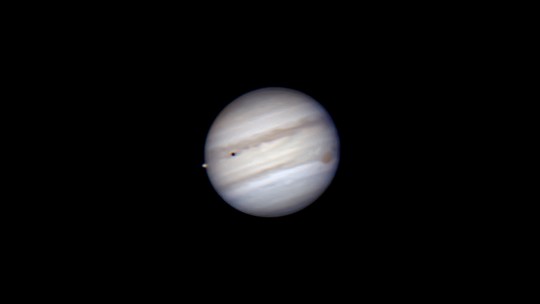
Jupiter with the GRS and io starting a transit via /r/spaceporn https://ift.tt/37LS7Xu
3 notes
·
View notes
Photo

In this composite image from near-infrared light, two of Jupiter's moons are visible against the planet. The white circle in the middle of Jupiter is Io, and the blue circle at upper right is Ganymede. The three black spots are shadows cast by Io, Ganymede, and another moon, Callisto.
Image Credit: NASA, ESA, and E. Karkoschka (University of Arizona)
5K notes
·
View notes
Photo

Triple Transit and Mutual Events : These three panels feature the Solar System's ruling gas giant Jupiter on August 15 as seen from Cebu City, Phillipines, planet Earth. On that date the well-timed telescopic views detail some remarkable performances, transits and mutual events, by Jupiter's Galilean moons. In the top panel, Io is just disappearing into Jupiter's shadow at the far right, but the three other large Jovian moons appear against the planet's banded disk. Brighter Europa and darker Ganymede are at the far left, also casting their two shadows on the gas giant's cloud tops. Callisto is below and right near the planet's edge, the three moons in a triple transit across the face of Jupiter. Moving to the middle panel, shadows of Europa and Ganymede are still visible near center but Ganymede has occulted or passed in front of Europa. The bottom panel captures a rare view of Jovian moons in eclipse while transiting Jupiter, Ganymede's shadow falling on Europa itself. From planet Earth's perspective, similar mutual events, when Galilean moons occult and eclipse each other, can be seen every six years or so when Jupiter is near its own equinox. via NASA
612 notes
·
View notes
Photo

Fireworks? Pshaw... In what may be a broader view, it was a big night celestially. Full Buck moon with a penumbral eclipse. Not too mention the 4 brightest moons of Jupiter...Io, Europa, Callisto and Ganymede. . #buckmoon #eclipse #jupiter #jupitersmoons #io #callisto #europa #ganymede #transitions #bestlife #peace #comfort #fullmoon #fulllife #manifestation #prosperity (at Lane County, Oregon) https://www.instagram.com/p/CCQHYo6h5iI/?igshid=10a88uvvt9qhg
#buckmoon#eclipse#jupiter#jupitersmoons#io#callisto#europa#ganymede#transitions#bestlife#peace#comfort#fullmoon#fulllife#manifestation#prosperity
0 notes
Text
NASA’s Juno spacecraft captured this view of Jupiter during the mission’s 40th close pass by the giant planet on Feb. 25, 2022. The large, dark shadow on the left side of the image was cast by Jupiter’s moon Ganymede.
Citizen scientist Thomas Thomopoulos created this enhanced-color image using raw data from the JunoCam instrument (Figure A). At the time the raw image was taken, the Juno spacecraft was about 44,000 miles (71,000 kilometers) above Jupiter’s cloud tops, at a latitude of about 55 degrees south, and 15 times closer than Ganymede, which orbits about 666,000 miles (1.1 million kilometers) away from Jupiter.
An observer at Jupiter’s cloud tops within the oval shadow would experience a total eclipse of the Sun. Total eclipses are more common on Jupiter than Earth for several reasons. Jupiter has four major moons (Galilean satellites) that often pass between Jupiter and the Sun: in seven days, Ganymede transits once; Europa, twice; and Io, four times. And since Jupiter’s moons orbit in a plane close to Jupiter’s orbital plane, the moon shadows are often cast upon the planet.
JunoCam captured this image from very close to Jupiter, making Ganymede’s shadow appear especially large. Figure B, created by citizen scientist Brian Swift using JunoCam data, illustrates the approximate geometry of the visible area, projected onto a globe of Jupiter.
Image data: NASA/JPL-Caltech/SwRI/MSSS
Image processing by Thomas Thomopoulos

#space photography#space science#space exploration#space#outer space#universo#astronomy#jupiter#news#science#astronomy photography#astrophotography#ganymede
26 notes
·
View notes
Photo

Jupiter and an Io transit on October 17, 2021 // Niall MacNeill
#astronomy#astrophotography#solar system#planet#gas giant#jupiter#great red spot#moon#jovian moons#galilean moons#io
58 notes
·
View notes